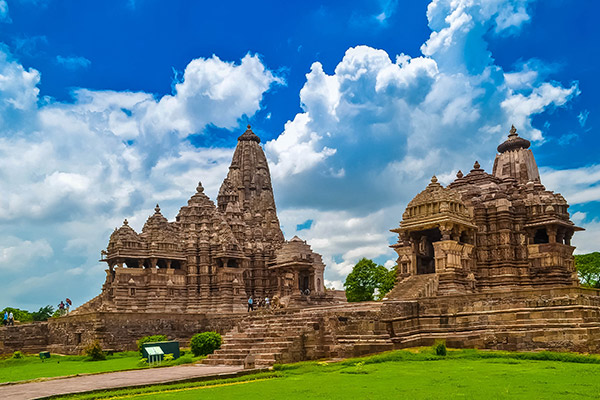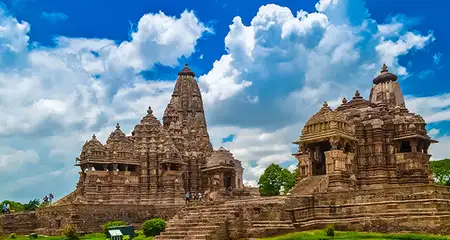The Khajuraho Group of Monuments (Temples) in Madhya Pradesh is a splendid saga of architectural brilliance that draws tourists from all over the world. With a history of around 1000 years, these temples are a living example of India’s artistic and cultural heritage. The erotic sculptures in these temples are among the finest ones in the world that depict passion in a spellbinding manner. These temples also feature sculptures that portray the symbolic values and daily life in ancient Indian culture. Undoubtedly, Khajuraho is one of the top heritage monuments in the country.
Are you planning a trip to Madhya Pradesh? Then keep aside some time in your itinerary to explore these magnificent temples that have been declared as a UNESCO World Heritage Site. Here’s everything you need to know about the Khajuraho temples, including their history, architecture, timings, entry fee, and other interesting facts.
Khajuraho Information:
| Location | Chhatarpur | |
| Timings | 8:00 am to 6:00 pm | |
| Entry Fee | ₹ 30 for Indians; ₹ 500 for foreigners | |
| Camera | Free | |
| Nearest Airport | Khajuraho Airport | |
| Nearest Railway Station | Khajuraho Station | |
| Date of Construction | 950 and 1050 CE | |
| Built by | Rulers of the Chandela dynasty | |
| Status | UNESCO World Heritage Site | |
| Architectural Style | Nagara Style | |
Khajuraho: History
Inscriptions at the Khajuraho temples indicate that these shrines were constructed from the period of 950 to 1050 AD. The construction of the temple is attributed to the rulers of the Chandela dynasty. It is believed that the temple site, covering an area of 20 sq. km had around 85 temples during the 12th-century. However, only 25 temples out of these have managed to defy the test of time and survive till date. These temples are spread across an area of 6 sq. km today.
It’s interesting to note that the Khajuraho group of temples are linked to two religions – Jainism and Hinduism. The Kandariya Mahadeva Temple is the largest and the most famous one among the surviving temples. It is adorned with innumerable sculptures exhibiting intricate details that mirror the richness of ancient Indian architecture.
Till the end of the 12th-century, these temples were active places of worship. But from 13th-century to 18th-century, these temples suffered massive destruction as the region came under the control of different Muslim dynasties. These temples were also the target of Sikandar Lodi’s drive in the 15th-century to destroy Hindu temples. After a long period of destruction and neglect, the temples at Khajuraho were rediscovered by T.S. Burt, a British surveyor, in the 1830s. Since then, the temples have gained popularity among travelers from all around the world.
Khajuraho: Architecture
The Khajuraho temples feature Nagara-style of architectural symbols. They are best known for the erotic sculptures that adorn the temple walls. Built upon granite foundations, these temples are made using sandstone. Like most Hindu temples, the shrines at Khajuraho follow the Vastu-Purusha-Mandala design plan.
Another characteristic feature of these temples is that the sculptures are arranged in symmetric repeating arrangements, even though every image is unique. Highly ornate carvings adorn the walls, pillars, ceilings of these temples. Several panels and sculptures in these temples have inscriptions. Barring one, every temple at Khajuraho faces the east and has an entrance in this direction.
Khajuraho: Today
Today, Khajuraho stands as one of the best places to visit in Madhya Pradesh to witness ancient India’s architectural prowess. The temples at Khajuraho were declared a UNESCO World Heritage Site in 1982 for their unique artistic beauty. These temples are classified into three groups, namely the Eastern, the Western, and the Southern groups. Out of these three, only the Western group of temples provides an audio-guided tour facility. Every year in the month of February, the Khajuraho Dance Festival is organized within the temple premises for one week. This festival witnesses the performances of some of the expert classical dancers from across India. There’s also an Archaeological Museum at Khajuraho.
Khajuraho Light and Sound Show
In the evenings, a stunning light and sound show is held at the Khajuraho temples, in the open lawns and against the backdrop of these heritage temples, it is one of the best light and sound shows in India. The show takes you through the interesting history of the temples.
- Duration: 50 minutes
- Timings:
October to February – 6:30 pm to 7:25 pm (English); 7:40 pm to 8:35 pm (Hindi)
March to September – 7:30 pm to 8:25 pm (English); 8:40 pm to 9:35 pm (Hindi) - Tickets: ₹ 300 for Indians; ₹ 700 for foreigners
Lesser Known Facts about Khajuraho
- Khajuraho is counted among the four holy sites connected to Lord Shiva. The other places are Kashi, Kedarnath, and Gaya.
- The Matangeshwara temple in Khajuraho is an active place of worship even today.
- The Bhand Deva Temple in Rajasthan, constructed in the 10th-century, depicts the style of the Khajuraho temples. So, it’s known as Little Khajuraho.
- The Kandariya Mahadev temple at Khajuraho is the most visited shrine there and has more than 870 sculptures adoring it.
- While Khajuraho is known for its erotic sculptures, they form less than 10% of the temple sculptures.
Khajuraho Museum
The Archaeological Museum at Khajuraho is a treasure trove of sculptures and carved art pieces. Established in 1967, the museum has five galleries. There are more than 3000 sculptures in the museum, out of which only 110 have been displayed for the public.
- Museum Timings: 10:00 am to 5:00 pm; closed on Mondays
- Entry Fee for Museum: ₹ 20 for Indians; ₹ 100 for foreigners
Attractions near Khajuraho
- Beni Sagar Dam (6.4 km)
- Jain Museum (3.2 km)
There’s no doubt that Khajuraho is one of the most fascinating places to visit in India. Make a trip to the temple to witness its rich architectural heritage and admire the skill of the ancient craftsmen who had constructed these stupendous works of art.


























